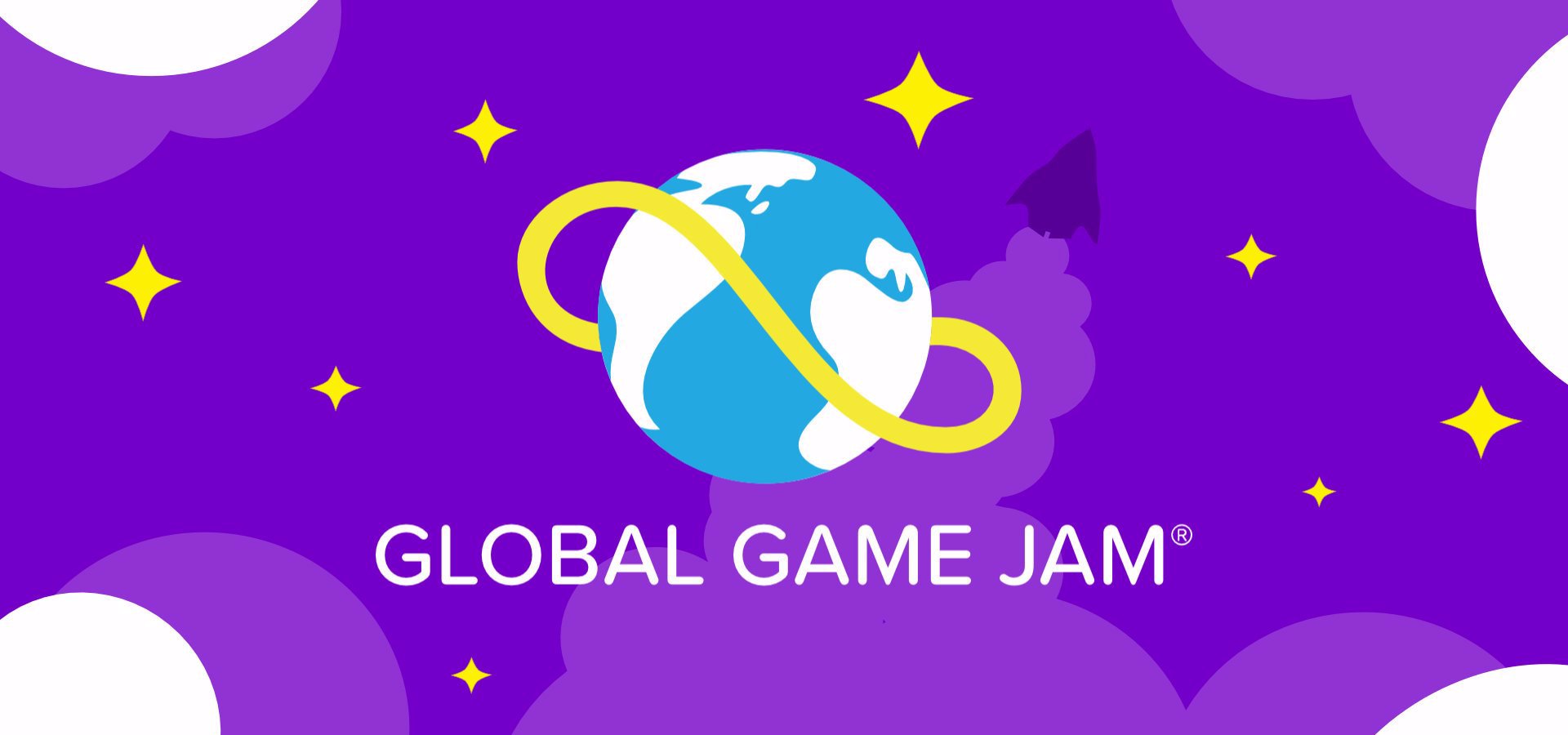What is a game audio engine?
A game audio engine is the underlying technology that will power your game's audio. Most game engines and frameworks have built-in features to help you add audio to your game, be it music or sound effects. Besides the audio features that are part of an engine's feature set there is also another option known as: Audio middleware.
Audio middleware solutions can be used to power your game audio instead, providing you with an alternative audio engine.
Why should I care about an audio engine?
When planning a new video game project an obvious decision that has to be made is the choice of the base technology that will power it, which generally means a game engine or a game framework of some sort. This is indeed a very important decision, as depending on the game being planned some options may be better suited than others in order to bring that specific project to life. If for example we'll be building a tilemap based game, choosing an engine that has a built-in tilemap editor and/or helpful features to build tilemap games will probably allow us to save precious development time. This, in turn, will allow us to ship the game faster or leave us with more free time to spend on polishing the game or adding additional features. Choosing an audio engine is no different.
Audio in games has the potential become quite complex. The reason audio middleware tools were created was to help developers design complex audio behaviours and music systems in an easier way.
How do the built-in features of game engines differ from audio middleware?
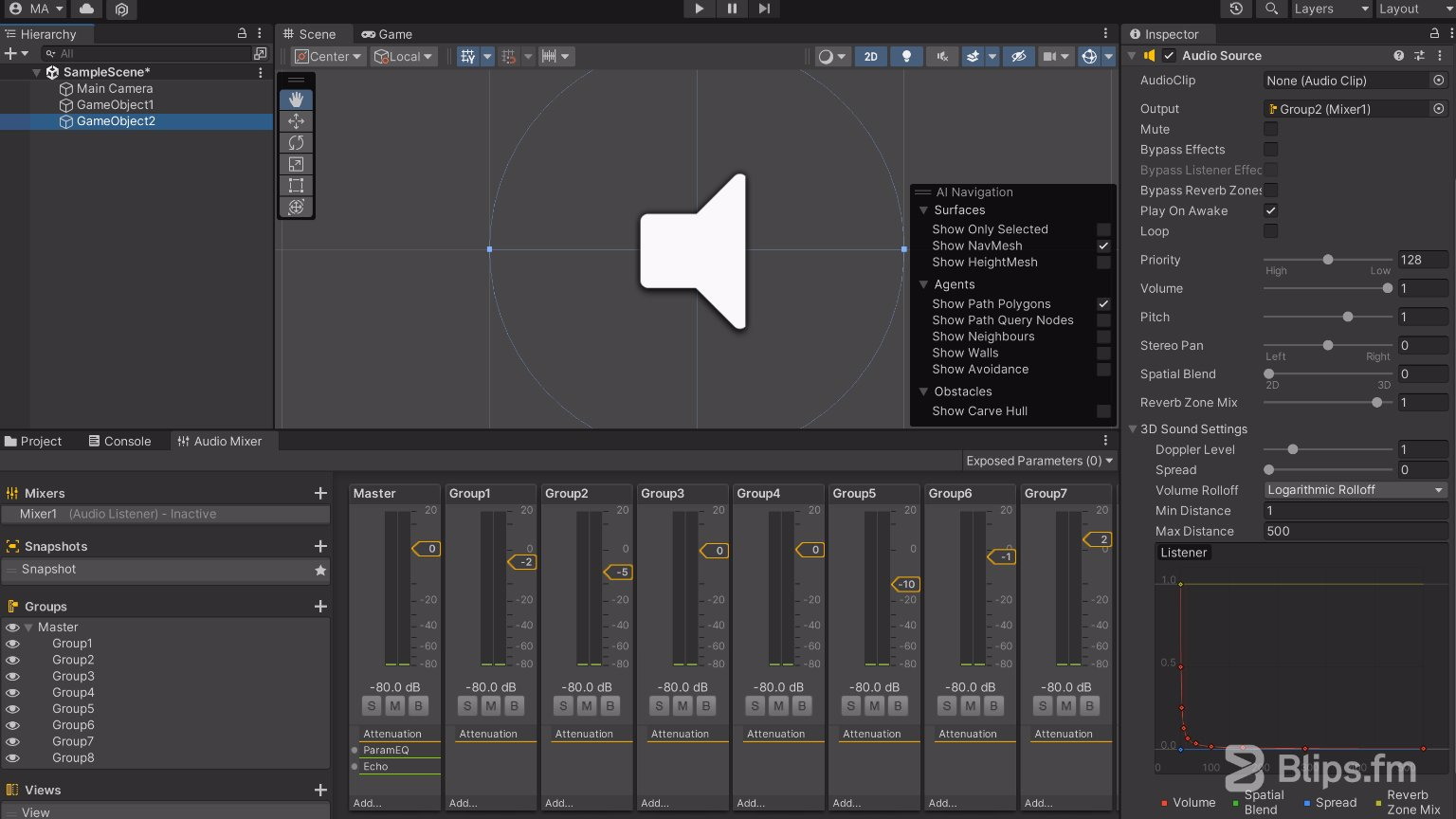
The mixer and an audio source component in the Unity game engine
Fortunately, today game engines already feature some powerful audio tools, and many things can be accomplished with them. Popular game engines include tools for positional audio, a collection of sound effects, ambisonics support and more. The audio features available are, of course, dependant on the chosen game engine.
Although those audio features are a good starting point they generally lack flexibility, with most audio behaviours needing to be programmed along with the rest of the game's systems. Some features available in audio middleware can be easier to replicate in a game engine with code and the built-in audio tools but others can require hundreds or thousands of hours of programming and a deep understanding of audio and digital signal processing.
Let's have a look at features available in audio middleware that generally aren't available in game engines. Keep in mind that I'm using generic terms here, as different audio middleware solutions can have different terms for similar functionality:
Events
Events allow for the grouping of audio tracks. Tracks can be moved in time, trimmed, mixed, faded and be triggered as single audio events.

Multiple audio tracks inside an event using the FMOD audio middleware
Asset management and preview
Audio middleware makes it easier to manage a large number of audio assets. You can often aggregate multiple audio files in single events, and events may be grouped inside folders, which makes it easier to manage all of the project's audio in one place. The ability to preview audio files, audio events and custom audio behaviours without having to jump around between different areas of a game engine or entering "play mode" also helps to keep you focused on the audio tasks at hand, which makes dealing with audio integration a way more pleasant experience.
Positional audio
Although some game engines do provide positional audio features, audio middleware generally goes beyond the basics by providing more ways in which audio can be perceived, like ahead, behind, above or below the listener. Note though that these features may depend on technologies such as Dolby Atmos, DTS:X or Sony 3D Audio for example. Audio middleware can also provide features such as distance attenuation curves and options to control sound size and extents.
Looping tools
Looping tools in middleware are generally more powerful than what's provided by game engines, as they allow you to set arbitrary loop points that can also span multiple audio tracks. Snapping or alignment options are also generally available for tempo based audio.

Multiple loop regions represented as blue bars at the top of the window (FMOD)
Adaptive audio and randomization
One of the most important aspects of audio middleware is the ability to make audio adapt to the gameplay. You can quickly add parameters that change the audio in real-time. You could, for example, create a parameter that changes the volume of a whole event (with multiple tracks playing) while at the same time opening or closing a high-pass/low-pass filter. These parameters can then be invoked through code during gameplay to change the audio in endless ways.
Other important aspect is the randomization options. Randomization is critical for most games. We need to avoid tiring the player by always triggering the same sounds over and over again. Randomization is a great way to achieve less repetition. Randomization is generally also needed to provide for believable audio environments. Some randomization features present in audio middleware include trigger lists that allow you to select and play a new sound every time an event is triggered. Sounds can be triggered sequentially following the order of the list or randomly. This is very useful for footsteps or gun fire for example.
Other common randomization functionality is the ability to trigger sounds at random inside a specified time interval. This can be useful for example for the chirping of birds, dripping water or any other situation that demands a soundscape of randomly triggered sounds. These randomization tools can also include positional audio options.
Modulation and Automation
Parameters and effects inside an audio middleware solution can often be controlled by modulation. Modulation is a way to change parameters through time without having to continuously set them through code. For this task audio middleware can exhibit a number of modulators such as AHDSR envelopes, low frequency oscillators (LFOs) and envelope followers which allow you to affect audio in many useful ways.
Besides modulation tools, audio middleware can also provide automation. This means you can draw curves to change parameters instead (or additionally).
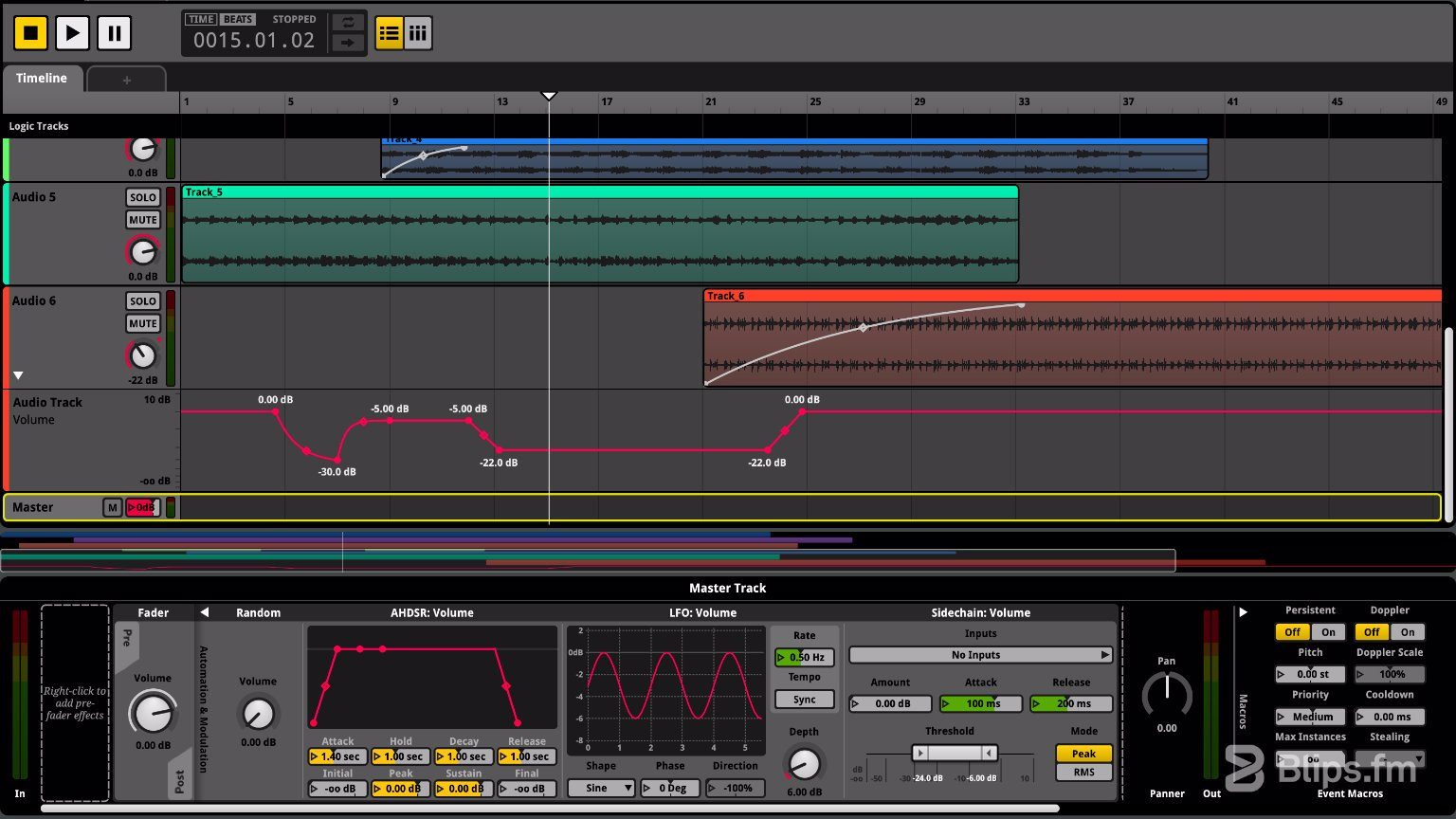
Automation lines and audio modulators at the bottom of the window (FMOD)
Mixing and Surround Sound
Surround sound audio is something that can be difficult to achieve without the help of middleware. Audio middleware enables the use of multichannel audio files as well as upmix and downmix features to adjust audio tracks for surround sound systems. Some audio middleware solutions can support speaker configurations of up to 7.1.4. They also generally make it easier to mix audio, be it for surround sound systems or not, with volume faders, panners and metering tools. They can also feature VCAs to make it easier to control the volume of groups of sounds/events and mixer snapshots.
Mixer snapshots can be used to change mixing configurations in real time. As for examples of use cases, you can imagine a situation where the player goes underwater. You could use a mixer snapshot to raise the volume of some audio sources, lower others while also muffling the sound. Another example could be the popular technique some games use for explosions. All of the sounds are lowered while introducing a continuous tone simulating ear ringing, then all the sounds come back up again after a few seconds.
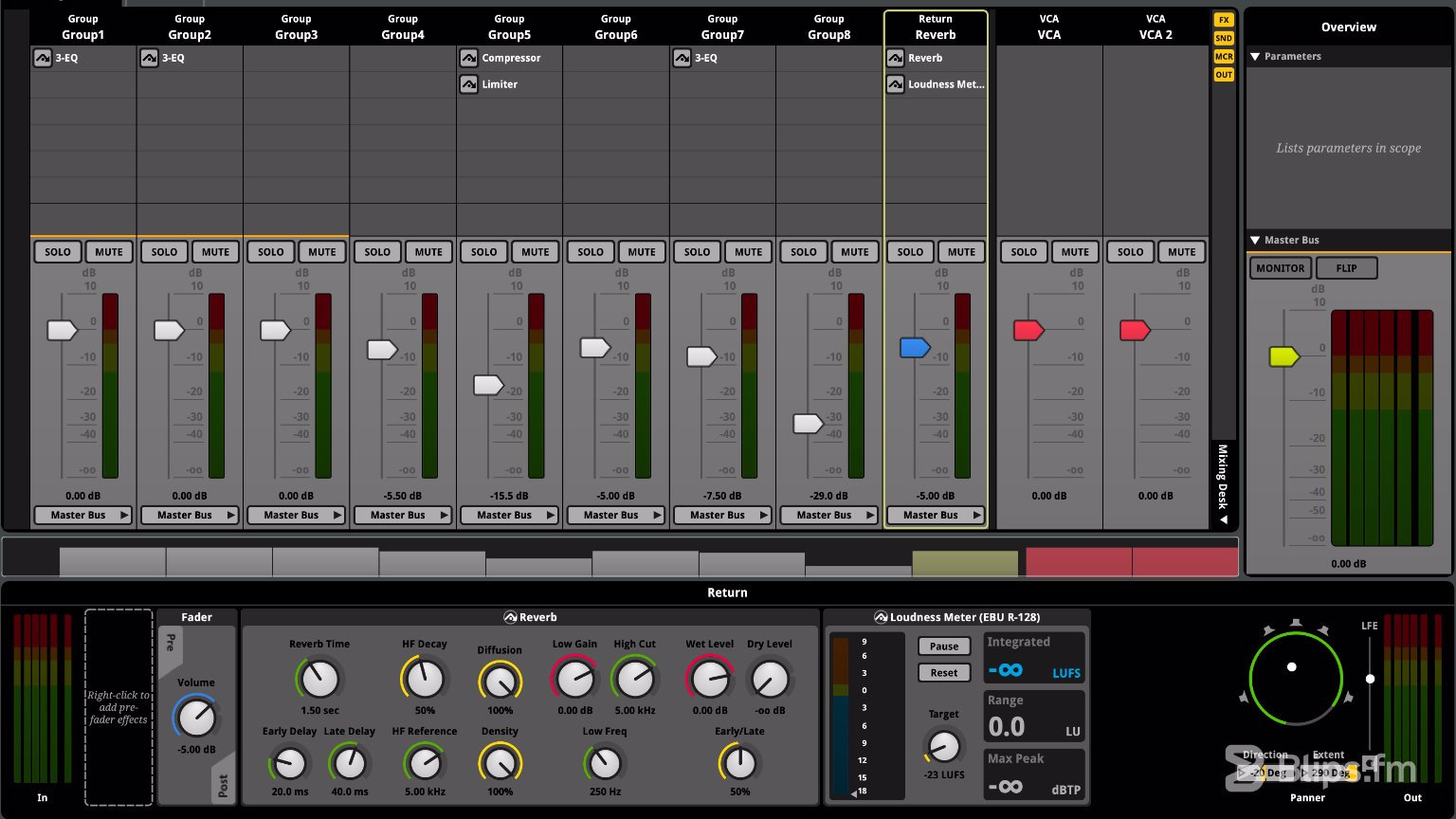
The mixer window displaying VCAs, loudness and surround sound meters (FMOD)
Audio Effects
There are generally a more diverse range and/or the effects have a more complete set of features in audio middleware. Some effects that are really useful and can be missing from game engines are: convolution reverbs with custom impulse response loading and limiters. The former allows for the creation of custom reverberation responses, the latter can keep audio under control, especially useful if multiple sounds can be triggered at the same time creating volume spikes/clipping.

Convolution reverb and limiter effects at the bottom of the window (FMOD)
Bank loading
Audio middleware can allow you to separate audio events into banks. This means you can load banks that only contain the sounds/music needed for a determined section or level of a game, allowing for a better management of resources on the game deployment targets.
Dialogue and Localization
Some audio middleware solutions may include tools to make it easier to manage dialogue. Using these tools will make it simple to play dialog lines while respecting the player's chosen language settings.
Testing
Audio middleware can provide you with tools to interactively test the designed audio behaviours by giving you some sort of “playground” or “soundbox” where sounds can be previewed and positioned in 3D space. This also alleviates the need to always test the designed behaviours in game, reducing the time it would take to test and iterate.
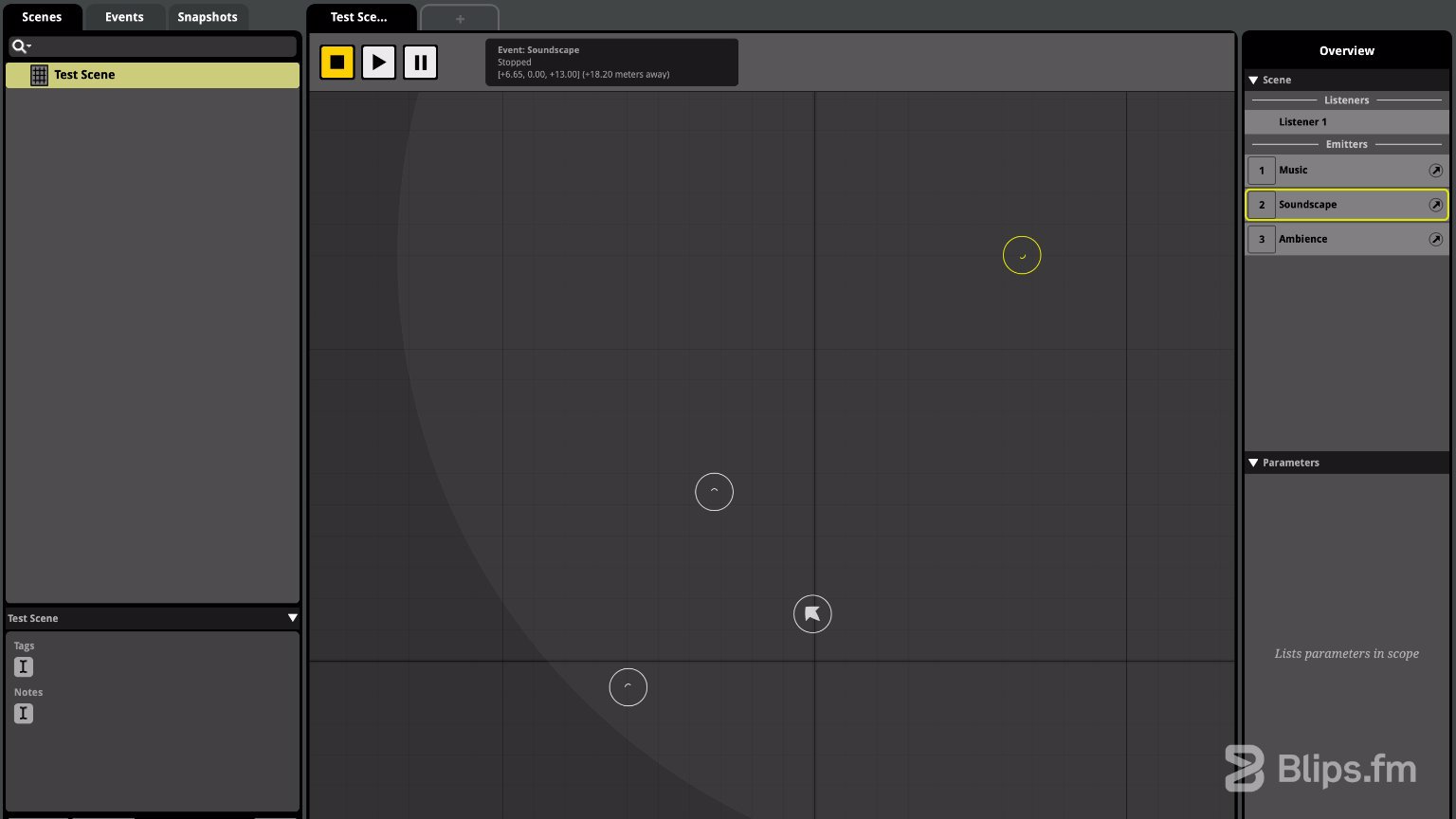
The FMOD "Sandbox" testing playground
Adaptive music
Another big advantage of audio middleware is the availability of tools for adaptive music. Music can be looped respecting tempo (BPM) and time signatures. Vertical music layers can easily be faded in and out. Horizontal music sequencing is also easy to implement by making use of markers and conditional logic for transitions.
Other features for music that are also commonly available are sustain points, transition offsets, and transition regions. These features can also be useful for compound sound effects.
As a side note, our adaptive music packs can easily be used inside an audio middleware solution. We even have an integration tutorial for FMOD that you can use to take the first steps using this audio tool. This tutorial is appropriate for total beginners. Music resources are also included!
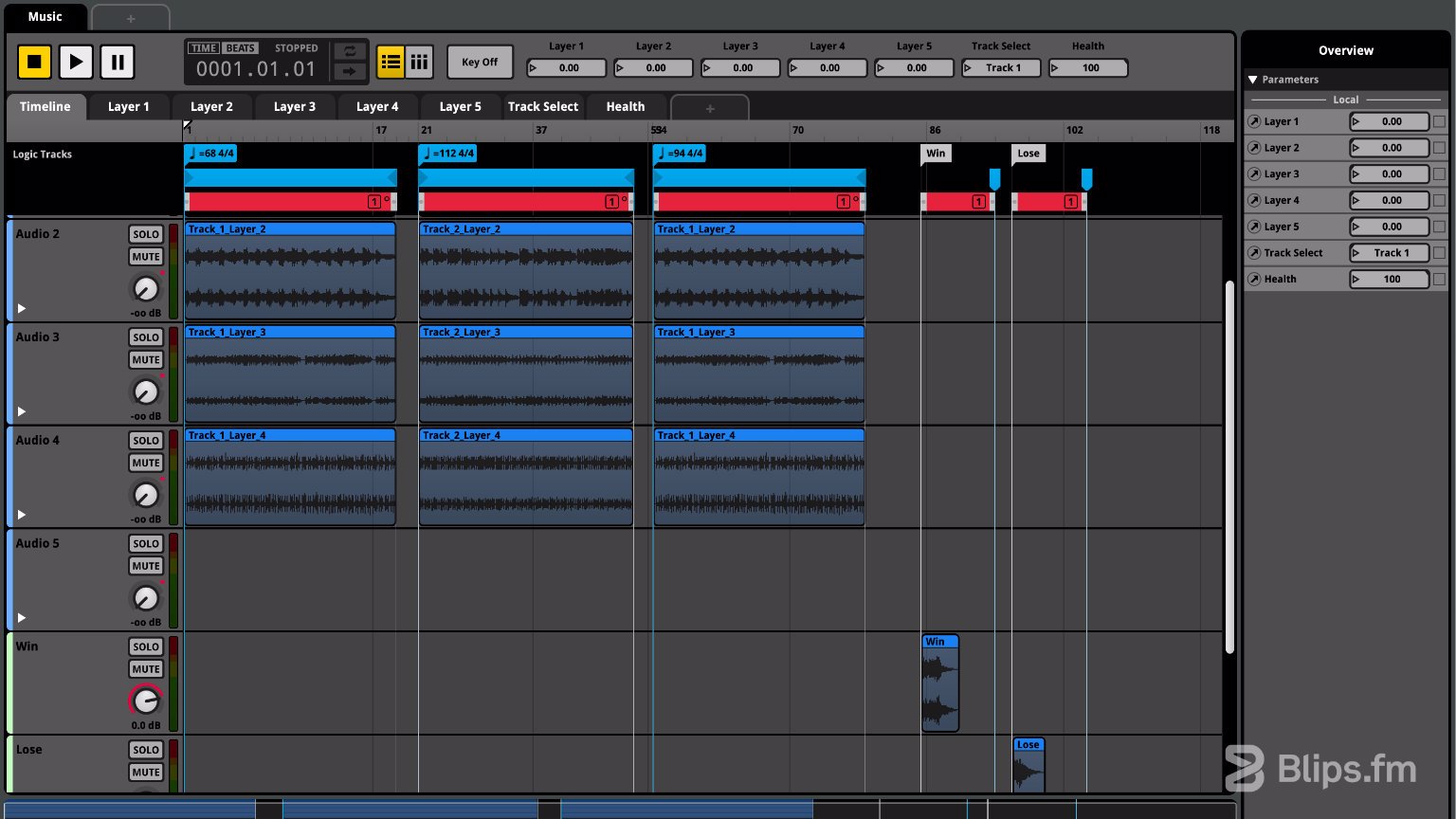
An adaptive music system using vertical layers and horizontal music sequencing (FMOD)
What audio middleware solutions are available to developers?
The audio middleware big names are Audiokinetic's Wwise and Firelight's FMOD although there are other middleware solutions available such as Criware CRI-ADX2 and Fabric.
How do I know what is the best option for my game?
Before diving deeper into the answer let's first have a look at the pros and cons of each choice:
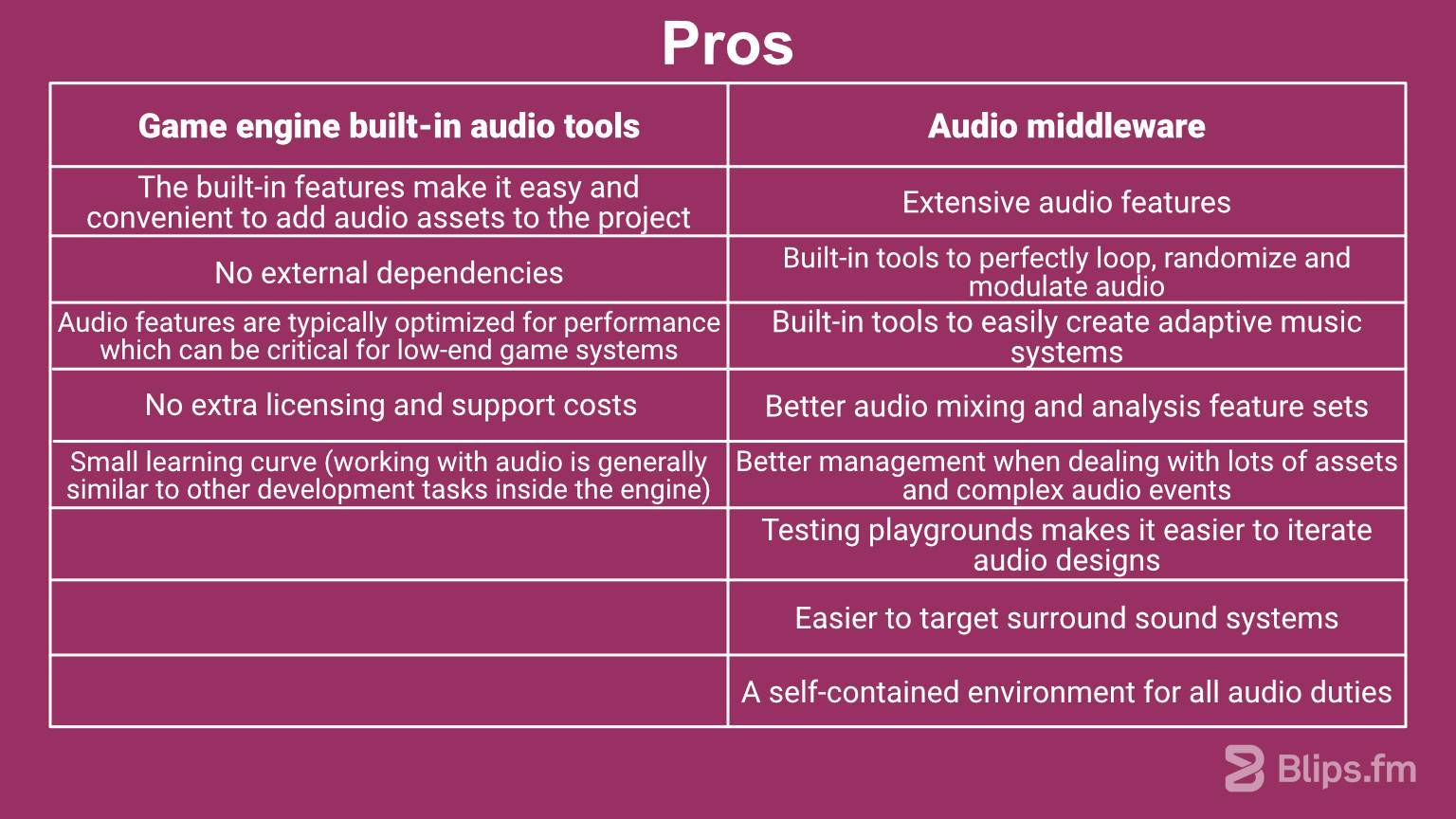

As you can see by the table above the use of a middleware solution comes out on top with a higher number of pros and a lower number of cons.
For now (as technology is always evolving) audio middleware is almost always a better solution to power a game's audio due to a focused audio environment, extended feature set, and better management of assets. The prominent cons are the licensing costs and the learning curve. Regarding the former it may not be a problem. Today popular middleware solutions are available to be used for free until some specified metric is reached, such as the amount of revenue per year or development budget. I recommend reading the licensing terms before opting for a middleware solution for your project.
Regarding the learning curve unfortunately there's no way around it. If audio programmers or sound designers with middleware knowledge are available on the team then it will probably be a no brainer, as long as the licensing terms aren't a show stopper. If not and if better audio is important to you (and it should be) learning a middleware solution even if in a more superficial way will most probably pay out in the long run, helping you deliver a better, more engaging experience for your public. We hope we'll be able to help you out with that task and other things audio here on the Blips Blog!
Conclusion
Unless the game being developed is very simple in nature, has a somewhat low number of assets, or makes use of just a tiny bit of adaptive audio and/or music, it will almost always be better to use an audio middleware solution. It isn't much the question of being possible or not to replicate middleware functionality using the game engine audio tools and programming, but the time it would take to do so in most scenarios. Building adaptive audio features for a game will end up consuming lots of development time that could be better spent on other development tasks. Most of the time it is better not to reinvent the wheel unless there's a strong reason to do so.
By using a middleware solution, you may also let your imagination free to build audio behaviours and use audio in a way that you wouldn't outside of a dedicated audio tool. Middleware can actually be a great playground to be let loose in. It allows you to dedicate more time and attention to audio which will most certainly help you achieve a better end result, which is a better game.
Do you use audio middleware? Do you intend to do so? Which one did you or will you choose?
Let us know in the comments!





